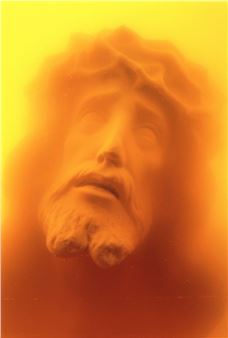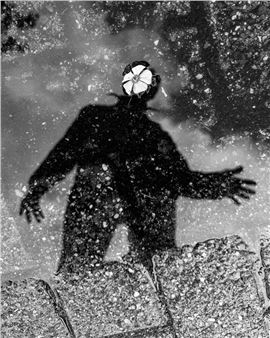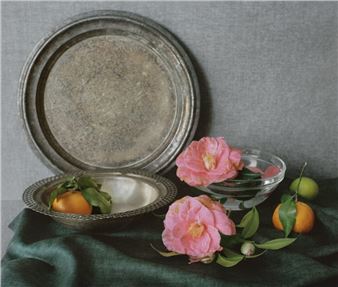RenГ© Magritte: La trahison des images
Surrealism found its definition of the beautiful in Lautréamont’s Chants de Maldoror: “Beautiful as the chance encounter of a sewing machine and an umbrella on a dissecting table.” This reflected the commitment of André Breton and his friends to the aesthetic of chance and shock found in the early collages of Max Ernst and in the movement’s first literary productions. It was this “beauty” that René Magritte discovered in 1923, when he first saw a reproduction of a painting by Giorgio De Chirico, his The Song of Love. Here, a red rubber glove and a plaster moulding of the head of a Greek god took the places of the sewing machine and the umbrella. Magritte was electrified, and for a number of years he too experimented with the juxtaposition of jockeys and cup-and-ball toys, curtains and wigs…
It wasn’t long afterwards, in 1927, that he made his first word paintings, combining the image of an object with a written definition that had no logical relation to it (the image of handbag being captioned ciel, the French for sky, that of a penknife with l’oiseau, “the bird”). The word paintings opened a new chapter in Magritte’s artistic development, conveying a complex reflection on the very nature and status of words and images. Quietly, almost unnoticed, they put into question philosophy’s traditional privileging of word over image. In a talk (“La Ligne de Vie”) given in Antwerp in 1938, Magritte explained the significance of the shift: “One night in 1936 I awoke in a room where they had put a cage with a bird sleeping in it. A magnificent error caused me to see an egg in the cage, instead of the bird. I then grasped a new and astonishing poetic secret, because the shock I experienced had been provoked precisely by the affinity of two objects, the cage and the egg, whereas previously I used to provoke this shock by bringing together objects that were unrelated. […] I sought to discover if objects other than the cage could not likewise manifest—by bringing to light some element peculiar to them and rigorously predetermined—the same evident poetry that the conjunction of the egg and the cage had succeeded in producing.” Abandoning the chance encounter, the random, the accidental, Magritte’s paintings became as rigorously constructed as mathematical formulae, each the solution to what he called a “problem”: “Since this research could yield only one exact response for each object, my investigations resembled the pursuit of the solution to a problem for which I had three data: the object, the thing connected with it in the shadow of my consciousness, and the light wherein that thing would become apparent.”
Magritte’s turn to the ratiocinative owed a great deal to Paul Nougé, the founding figure of Belgian Surrealism. A scientist by training, Nougé imparted to the Belgian movement an orientation rather different from that of its French counterpart, a realism and a “scientism” closely connected to his Marxist convictions. Magritte too adhered to this orientation, which quickly saw him come to understand his work as a cognitive tool at the service of thought, to identify painting with thought itself. This was an ambition that could only clash with the convictions of the French Surrealists, whom Magritte got to know in 1927. The figures he was particularly close to were about to turn to what Breton would soon term a “reasoning” Surrealism. From the Hegel who became required reading, they borrowed the dialectic, soon recruited to all their pet purposes, and in Hegel’s Aesthetics they found confirmation of their belief in the pre-eminence of poetry over all other forms of art. Magritte had to react to this insidious iconoclasm, and in 1929 he published in La Révolution surréaliste an illustrated essay in which he analysed the relation between words and images. That same year he painted La Trahison des images (The Treachery of Images), an ironic illustration of the meretricious character he feigned to attribute to his art.
If the years before the war saw Magritte do battle with poets, the period after it was philosophers who became his interlocutors. Having heard him lecture on Belgian public radio, Magritte began a correspondence with Alphonse de Waelhens, the first person to translate Heidegger’s Being and Time into French. Advised by Waelhens to read Merleau-Ponty, Magritte reported to him that “Merleau-Ponty’s most brilliant argument is very nice to read, but it hardly makes one think of painting – which he nonetheless seems to be dealing with. I would even say that when he does, he discusses painting as if he were discussing a philosophical work by considering the author’s pen and paper.” In the early 1960s, he began a sustained correspondence with Chaïm Perelman. After the latter suggested he read Maurice-Jean Lefebvre’s L’Image fascinante et le surréel, he responded: “I have read L’Image fascinante, which you were kind enough to send me. I read this brilliant analysis of the image with that pleasure one has from reading certain kinds of science fiction, without finding anywhere a treatment of the imagination, of Surrealism or of the unreal, such as they deserve.” Even if Waelhens and Perelman became his friends, members of his philosophical think-tank, he gave not an inch in the face of their efforts to annexe his art, to exercise intellectual authority over it.
“FINDING ANYWHERE A TREATMENT OF THE IMAGINATION, OF SURREALISM OR OF THE UNREAL, SUCH AS THEY DESERVE.”
In 1966, Magritte discovered a book whose title could not fail to catch his attention, Foucault’s Words and Things, and immediately embarked on a correspondence with its author, an exchange that led to Foucault’s publication of Ceci n’est pas une pipe (This is not a pipe) in 1973. Magritte’s goal of winning recognition for his art as a fully-fledged expression of thought or mind came into endless conflict with a philosophical tradition that condemned the image for its problematic relation to reality and truth. In its deliberately limited iconographic vocabulary and endless restaging of the same elements (shadows, flames, words, curtains, and bodies in pieces), Magritte’s painting suggests a systematic refutation of philosophy’s pretensions, its repeated anathemas on painting.
Words and Images
It was with the poets who made up most of the Surrealist ranks that Magritte engaged in his first battle to re-establish the intellectual dignity of his art: a battle against the “(supposed) stupidity of painters” earlier fought by Marcel Duchamp. It took the form of an inquiry, published in La Révolution surréaliste, into the status of words and images, into their possible inter-changeability, and also found expression in a painting, La Trahison des images (The Treachery of Images), a response to the definition of poetry offered a few months earlier by André Breton and Paul Eluard: “Poetry is a pipe”. This conflict between word and image has a long history, beginning with the Bible story of Moses breaking the Tables of the Law on seeing his people worship a graven image. “And Moses turned, and went down from the mountain with the two tablets of the testimony in his hands, tables that were written on both sides; on the one side and on the other were they written. And the tables were the work of God, and the writing was the writing of God, graven upon the tables. … And as soon as he came near the camp and saw the calf and the dancing, Moses’ anger burned hot, and he threw the tables out of his hands and broke them at the foot of the mountain” (Exodus 32).
The Cave
No text has contributed more to the philosophical discredit into which the image has fallen than Plato’s Allegory of the Cave. Some have seen in it a critique of our representations, the fruit of an imperfect perception of reality that condemns them to the status of a shadow-play that habit and convention persuade us to take for reality itself. “To them … the truth would be literally nothing but the shadows of the images.” Magritte several times pictured this Platonic fable, isolating and rearranging its constituent elements: fire, and the view from within an enclosed space, whether cave, room or building.
The Invention of Painting
Shadow plays a role too in the account of the invention of painting offered by Pliny the Elder: “Being deeply in love with a young man about to depart on a long journey [the daughter of Butades, the potter of Sicyon] traced the profile of his face, as if thrown upon the wall by the light of the lamp. Upon seeing this, her father filled in the outline, by compressing clay upon the surface, and so made a face in relief, which he then hardened by fire along with other articles of pottery.” From this narrative Magritte takes the identification of model with outline, the erotic impulse behind his art.
Parrhasius’ Curtain
Elsewhere in his Natural History, Pliny takes a painted curtain as the most perfect expression of the painterly illusionism vaunted by Parrhasius: “This last, it is said, entered into a pictorial contest with Zeuxis, who represented some grapes, painted so naturally that the birds flew towards the spot where the picture was exhibited. Parrhasius, on the other hand, exhibited a curtain, drawn with such singular truthfulness, that Zeuxis, elated with the judgement that had been passed upon his work by the birds, haughtily demanded that the curtain should be drawn aside to let the picture be seen. … With a great degree of ingenuous candour he admitted that he had been surpassed, for that whereas he himself had only deceived the birds, Parrhasius had deceived him, an artist.” Repeating Parrhasius’ gesture, the painters of the Dutch Golden Age liked to picture a curtain half-hiding the still lifes they painted with a realism that verged on trompe l’oeil. Vermeer and Rembrandt made use of the same stratagem, taking an ironic distance from their own virtuoso realism. Magritte, perhaps the most naturalistic of modern painters, also regularly featured curtains in his work.
The Fragmentary Body
With his account of the origins of the painting of a perfect beauty by the renowned Zeuxis, Cicero bequeathed painters the idea of a beauty necessarily composite (Ingres would remember this rule in painting La Source). Magritte constantly played on this classical theme of fragmentary beauty, offering pictorial variations of the laws of classical harmony (which becomes, under his brush, a Folie des grandeurs).
Didier Ottinger
Surrealism found its definition of the beautiful in Lautréamont’s Chants de Maldoror: “Beautiful as the chance encounter of a sewing machine and an umbrella on a dissecting table.” This reflected the commitment of André Breton and his friends to the aesthetic of chance and shock found in the early collages of Max Ernst and in the movement’s first literary productions. It was this “beauty” that René Magritte discovered in 1923, when he first saw a reproduction of a painting by Giorgio De Chirico, his The Song of Love. Here, a red rubber glove and a plaster moulding of the head of a Greek god took the places of the sewing machine and the umbrella. Magritte was electrified, and for a number of years he too experimented with the juxtaposition of jockeys and cup-and-ball toys, curtains and wigs…
It wasn’t long afterwards, in 1927, that he made his first word paintings, combining the image of an object with a written definition that had no logical relation to it (the image of handbag being captioned ciel, the French for sky, that of a penknife with l’oiseau, “the bird”). The word paintings opened a new chapter in Magritte’s artistic development, conveying a complex reflection on the very nature and status of words and images. Quietly, almost unnoticed, they put into question philosophy’s traditional privileging of word over image. In a talk (“La Ligne de Vie”) given in Antwerp in 1938, Magritte explained the significance of the shift: “One night in 1936 I awoke in a room where they had put a cage with a bird sleeping in it. A magnificent error caused me to see an egg in the cage, instead of the bird. I then grasped a new and astonishing poetic secret, because the shock I experienced had been provoked precisely by the affinity of two objects, the cage and the egg, whereas previously I used to provoke this shock by bringing together objects that were unrelated. […] I sought to discover if objects other than the cage could not likewise manifest—by bringing to light some element peculiar to them and rigorously predetermined—the same evident poetry that the conjunction of the egg and the cage had succeeded in producing.” Abandoning the chance encounter, the random, the accidental, Magritte’s paintings became as rigorously constructed as mathematical formulae, each the solution to what he called a “problem”: “Since this research could yield only one exact response for each object, my investigations resembled the pursuit of the solution to a problem for which I had three data: the object, the thing connected with it in the shadow of my consciousness, and the light wherein that thing would become apparent.”
Magritte’s turn to the ratiocinative owed a great deal to Paul Nougé, the founding figure of Belgian Surrealism. A scientist by training, Nougé imparted to the Belgian movement an orientation rather different from that of its French counterpart, a realism and a “scientism” closely connected to his Marxist convictions. Magritte too adhered to this orientation, which quickly saw him come to understand his work as a cognitive tool at the service of thought, to identify painting with thought itself. This was an ambition that could only clash with the convictions of the French Surrealists, whom Magritte got to know in 1927. The figures he was particularly close to were about to turn to what Breton would soon term a “reasoning” Surrealism. From the Hegel who became required reading, they borrowed the dialectic, soon recruited to all their pet purposes, and in Hegel’s Aesthetics they found confirmation of their belief in the pre-eminence of poetry over all other forms of art. Magritte had to react to this insidious iconoclasm, and in 1929 he published in La Révolution surréaliste an illustrated essay in which he analysed the relation between words and images. That same year he painted La Trahison des images (The Treachery of Images), an ironic illustration of the meretricious character he feigned to attribute to his art.
If the years before the war saw Magritte do battle with poets, the period after it was philosophers who became his interlocutors. Having heard him lecture on Belgian public radio, Magritte began a correspondence with Alphonse de Waelhens, the first person to translate Heidegger’s Being and Time into French. Advised by Waelhens to read Merleau-Ponty, Magritte reported to him that “Merleau-Ponty’s most brilliant argument is very nice to read, but it hardly makes one think of painting – which he nonetheless seems to be dealing with. I would even say that when he does, he discusses painting as if he were discussing a philosophical work by considering the author’s pen and paper.” In the early 1960s, he began a sustained correspondence with Chaïm Perelman. After the latter suggested he read Maurice-Jean Lefebvre’s L’Image fascinante et le surréel, he responded: “I have read L’Image fascinante, which you were kind enough to send me. I read this brilliant analysis of the image with that pleasure one has from reading certain kinds of science fiction, without finding anywhere a treatment of the imagination, of Surrealism or of the unreal, such as they deserve.” Even if Waelhens and Perelman became his friends, members of his philosophical think-tank, he gave not an inch in the face of their efforts to annexe his art, to exercise intellectual authority over it.
“FINDING ANYWHERE A TREATMENT OF THE IMAGINATION, OF SURREALISM OR OF THE UNREAL, SUCH AS THEY DESERVE.”
In 1966, Magritte discovered a book whose title could not fail to catch his attention, Foucault’s Words and Things, and immediately embarked on a correspondence with its author, an exchange that led to Foucault’s publication of Ceci n’est pas une pipe (This is not a pipe) in 1973. Magritte’s goal of winning recognition for his art as a fully-fledged expression of thought or mind came into endless conflict with a philosophical tradition that condemned the image for its problematic relation to reality and truth. In its deliberately limited iconographic vocabulary and endless restaging of the same elements (shadows, flames, words, curtains, and bodies in pieces), Magritte’s painting suggests a systematic refutation of philosophy’s pretensions, its repeated anathemas on painting.
Words and Images
It was with the poets who made up most of the Surrealist ranks that Magritte engaged in his first battle to re-establish the intellectual dignity of his art: a battle against the “(supposed) stupidity of painters” earlier fought by Marcel Duchamp. It took the form of an inquiry, published in La Révolution surréaliste, into the status of words and images, into their possible inter-changeability, and also found expression in a painting, La Trahison des images (The Treachery of Images), a response to the definition of poetry offered a few months earlier by André Breton and Paul Eluard: “Poetry is a pipe”. This conflict between word and image has a long history, beginning with the Bible story of Moses breaking the Tables of the Law on seeing his people worship a graven image. “And Moses turned, and went down from the mountain with the two tablets of the testimony in his hands, tables that were written on both sides; on the one side and on the other were they written. And the tables were the work of God, and the writing was the writing of God, graven upon the tables. … And as soon as he came near the camp and saw the calf and the dancing, Moses’ anger burned hot, and he threw the tables out of his hands and broke them at the foot of the mountain” (Exodus 32).
The Cave
No text has contributed more to the philosophical discredit into which the image has fallen than Plato’s Allegory of the Cave. Some have seen in it a critique of our representations, the fruit of an imperfect perception of reality that condemns them to the status of a shadow-play that habit and convention persuade us to take for reality itself. “To them … the truth would be literally nothing but the shadows of the images.” Magritte several times pictured this Platonic fable, isolating and rearranging its constituent elements: fire, and the view from within an enclosed space, whether cave, room or building.
The Invention of Painting
Shadow plays a role too in the account of the invention of painting offered by Pliny the Elder: “Being deeply in love with a young man about to depart on a long journey [the daughter of Butades, the potter of Sicyon] traced the profile of his face, as if thrown upon the wall by the light of the lamp. Upon seeing this, her father filled in the outline, by compressing clay upon the surface, and so made a face in relief, which he then hardened by fire along with other articles of pottery.” From this narrative Magritte takes the identification of model with outline, the erotic impulse behind his art.
Parrhasius’ Curtain
Elsewhere in his Natural History, Pliny takes a painted curtain as the most perfect expression of the painterly illusionism vaunted by Parrhasius: “This last, it is said, entered into a pictorial contest with Zeuxis, who represented some grapes, painted so naturally that the birds flew towards the spot where the picture was exhibited. Parrhasius, on the other hand, exhibited a curtain, drawn with such singular truthfulness, that Zeuxis, elated with the judgement that had been passed upon his work by the birds, haughtily demanded that the curtain should be drawn aside to let the picture be seen. … With a great degree of ingenuous candour he admitted that he had been surpassed, for that whereas he himself had only deceived the birds, Parrhasius had deceived him, an artist.” Repeating Parrhasius’ gesture, the painters of the Dutch Golden Age liked to picture a curtain half-hiding the still lifes they painted with a realism that verged on trompe l’oeil. Vermeer and Rembrandt made use of the same stratagem, taking an ironic distance from their own virtuoso realism. Magritte, perhaps the most naturalistic of modern painters, also regularly featured curtains in his work.
The Fragmentary Body
With his account of the origins of the painting of a perfect beauty by the renowned Zeuxis, Cicero bequeathed painters the idea of a beauty necessarily composite (Ingres would remember this rule in painting La Source). Magritte constantly played on this classical theme of fragmentary beauty, offering pictorial variations of the laws of classical harmony (which becomes, under his brush, a Folie des grandeurs).
Didier Ottinger
Artists on show
Contact details


 ARTISTS
ARTISTS











